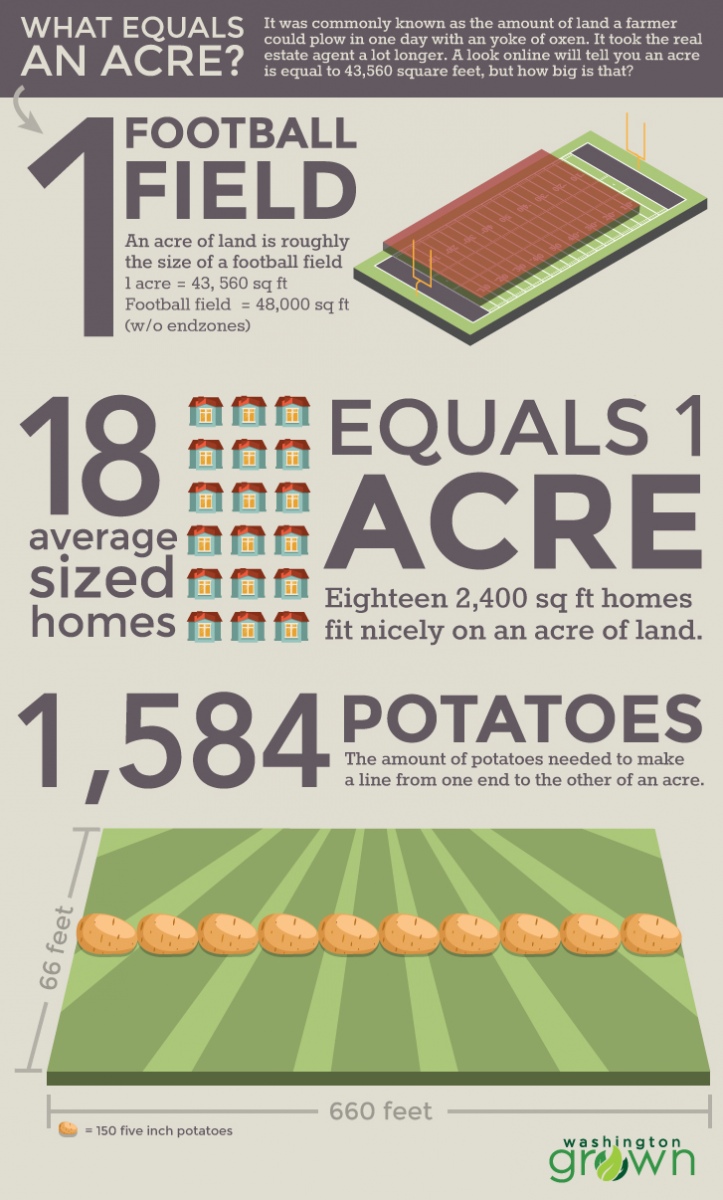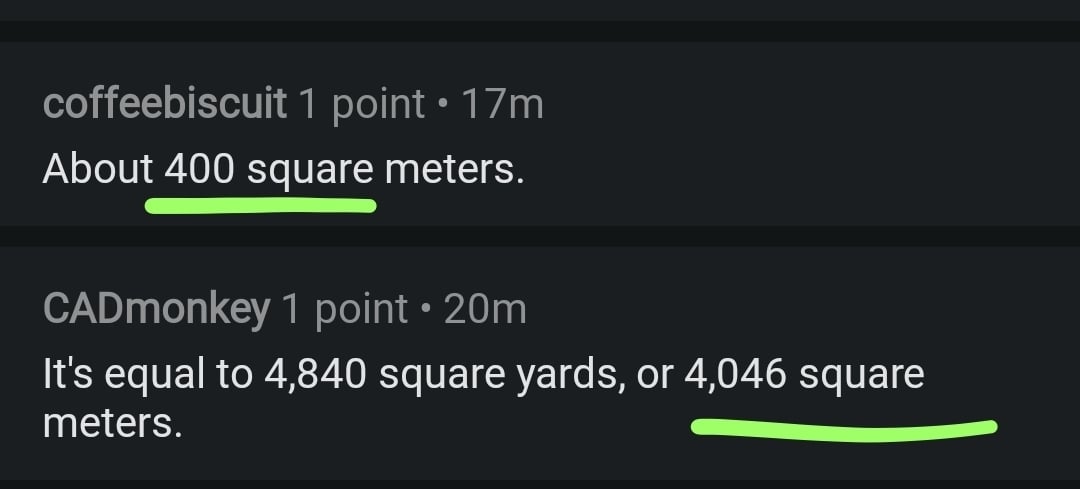
The more you know! doo doo doo… doo!🌈⭐
Ugh. Where did 660 feet come from? Where did 66 feet come from? A line of potatoes (linear) to measure an acre (area)? A strip of land 43,560 x 1 ft is an acre requiring 87k+ potatoes.
Also, 18 homes wont fit on an acre.
This graphic is fucking awful.
An acre is not just a unit of area measurement but has a traditional shape or aspect ratio per acre, based on the land plots it was used for.
1 acre is traditionally 60 ft x 660 ft, also known as 1 chain by 1 furlong.
It’s similar to if you said you could lay X potatoes across a football field. Yes a football field is an area but it also has a defined length.
I’m no expert but i believe that’s not how the term is used today. Like if a house is advertised as coming on a quarter acre of land, that says absolutely nothing about the dimensions of that land
True, I was just explaining where those numbers came from.
660 feet is a furlong, which comes from one furrow length. It’s the distance two oxen can pull a plow (creating a furrow), without stopping to rest. Then the oxen and person standing atop the plow could have a little rest before turning around to plow the next furrow. Not sure how many furrows but if you repeat this process all day, you’ll have plowed an acre. Potatoes did not exist to farmers when this land measurement was in use. But 66 x 660 is the original definition of an acre, and the only reasonable explanation for why we have 43,560
In California we measure water in Acre Feet. I guess if you know how many acres you have, and how many inches of water your crops need, I guess you’ll know how many acre feet you need.
660 * 8 is also 5280, or one mile.
That’s bull spit. I’ve trained my oxen to go 777 ft.
It is a chain (66ft) and 10 chains 660ft. They are historically important units for land surveying (and relevant today because of that). The measurement is nonsense, but the graph makes sense because an acre can be defined as 1 chain by 10 chains or 66ftx660ft=4356sqft
These numbers all come from people who preferred 12 and 60 as their working base numbers, not 10. A lot of it becomes really elegant once you understand that.
Did they use duodecimal or sexagesimal numeral systems?
66 feet does not match that, also its 1 chain * 10 chains.
and 10 chains = 1 furlong = 1/8 mile
Ya if you know that, you know what I’m talking about and just want to argue.
I do think a duodecimal system is elegant, I don’t see it being used with these numbers.
edit: ok, 660/12=55
Common denominator stuff.
You can divide 2400 square feet into an acre 18 times, but yeah… like, in most metros, even the kind of small detached single-family home you’d find in a inner-ring suburb is going to sit on a 5,000-8,000 square foot lot. Typical suburban lot sizes are more like a 1/4 acre.
This isn’t to say that a McMansion on a quarter acre of land is a good thing, but just as a point of reference, if you’re imagining a neighborhood of 15 to 20 homes and somebody tells you “that’s about an acre” you’re going to be off by an order of magnitude.
Most 2000sf+ homes, even in rural areas, are 2+ stories. That would leave room for yards. Not big yards, but yards.
My 750sf circa-1960 starter home in a turn-of-century streetcar suburb sits on a 7,500sf lot, and that’s relatively small for the area. You’d have to be talking about urban rowhouses as seen in East Coast cities to approach anything like a 2500sf lot size for a single family home.
You struggled with word problems in algebra classes didnt you?
^average SIZED homes
Probably, as long as they have absolutely no yards, and no way to get to the front door.
18*2,400=43,200, so they’d fit, but not nicely. It also doesn’t take external wall width into account, but that’s 20 extra feet per house for the outside walls.
That said, at least in my area, most of the houses in that size range are two story, so who knows what the footprint would be. Agreed, unhelpful metric.
JFC not a single magnitude in metric…
What? You don’t naturally measure things in potatoes per football field?
JFC not a single magnitude in metric…
Jentucky Fried Chicken?
Jesus Fucking Chicken?
Jesus Frying Chicken…
I just stole it from a place, sorry.
Sounds like communiss to me
JFC they were asking about a unit of measurement from the imperial system.
The average American home is 2400 sqft?
I live in a home that size… any time someone comes over they mention how big the house is. It feels huge, we moved from 985 sqft and a year later it still feels enormous. To think this is the average is a mind fuck LoL.
Where’s that stat from? Is that legit?
I am more amazed they fit 18 of them on one acre.
Really shines a light on to how we could have plenty of housing for everyone if we didn’t expect back yards.
Meanwhile, Europeans use hectares. Or a hundred ares. An are is 100 square metres, so a hectare is 100*100 or 10000 square metres or 1/100 of a square kilometer.
Thanks I hate it

Guys, I actually came here to learn something!
CADmonkey, DemBoSain, and HjFun are correct in this case. 43,560 sq. ft., or 4046.86 sq. meters.
Coffeebiscuit presumably dropped a zero accidentally.
0 here it is!
You stole it!
0 i found another one! Here ya go!
I live in a neighborhood that is all half acre lots. So an acre is two properties on my street. Easy!
I have a 3/4 acre lot. So it’s like my yard and the part of my neighbor’s yard I can see. Easy
The acre was defined officially as being 1 furlong (40 poles = 660 feet) in length, and 4 poles (66 feet) in breadth.
From the source of the problem.
Whip out your furlongs and poles. Bring some rods and chains, just in case.
Yea but if it’s cold my pole is shorter
There was shrinkage!
I remember it just as 1x10 chains which is still esoteric and just to check the math on the conversion factor of 1 acre = 43,560 sq. ft.
What the fuck’s a furlong???
edit: Google says it’s 1/8 of a mile… 201.17m for my SI people.
One of the base units of the superior velocity measurement, furlongs per fortnight.
1/8th of a mile per 14 days…
I don’t know if I should kiss you or kill you for this knowledge.
Grab a couple of oxen and a plough, and plough all day long. The amount you’ve done is about an acre
Is it called that because you’d be all acky after all that hard work? An ache’er?
Never thought of this but I love it haha
but what if my couple of oxen is faster than yours?
Then you didn’t plow as well, I guess?
I can visualize an acre really well.where I grew up, houses were standard on 1/4 acre blocks so it was just my house and my 3 neighbours houses.
Hectares though, these are the devils unit of area and Ill have no part in them!
I thought acre was English for the Spanish word “hectárea”. I guess I was wrong. Anyways, my mind always goes blank when people use these units. I can only understand once I hear squared meters or kilometers.
Edit: dude, an hectare is just 10k squared meters. Chef’s kiss. Meanwhile an acre is 4 neighboring houses from that Lemmy’s user, or 5000 potatoes spread on a field.
Yknow how hard it is to think in your second language? It’s the same here. I know metric how metric works perfectly well, but I convert to imperial to think, and then convert the answer back to metric for whatever person needed it in metric. I literally have all the conversions memorized but I just can’t think in metric. I say this because of the way you presented 10k square meters. Had to convert to miles to visualize and then was like “oh, a 16th of a mile squared”
But, Americans also don’t really know, and they’re steeped in that mess.
The real issue is “Do you really need to know or care?” in daily life. The odds are very, very great you don’t unless you are a farmer or surveyor and if you are, you will know.
It’s just like the trope of " 'Muricans" don’t know how long a mile is! Stupid feckers." But it doesn’t matter if you “know” how many inches, feet, rods, or chains there are in a mile for virtually everyone. Any of those other units would not be the best choice for the scale a mile is used for. Just like an astronomer doesn’t use miles or kilometers to measure the distance between stars - the scale of measurement is all wrong. Neither 'Murican or European cares about smaller units that make up miles or kilometers when traveling. Be honest - Do you really think about how many decimeters it is between Berlin and Paris? What you really care about is “How long will it take to get there.” And measuring travel by time is universal.
In any case, all measurement systems are just made up units thought up by some random dude. Use what is appropriate for what you need. If that’s metric, great! If it’s US Customary, awesome! If it’s SI, even better than either of the other two!
@bluewing @corsicanguppy well, if you want to run 2km and you have this track that is 200m long, you know how many times you need to run it without even thinking about it. If you want to run 2 miles and you have this track that is 200 yards long, you better have your phone with you to use the calculator
i’m pretty sure i can divide 3600 by 180 in my head. 20 laps will do it.
You are confusing absolute accuracy and required precision. No one needs to care about exactly how many meters or yards to run a kilometer or mile on a track. It’s about how many laps. If you are running a mile on a 200 yard track you know you will run 9 laps. And with only very minor exceptions, outdoor tracks in the US are 440 yards or 1/4 mile. So you know you will run 4 laps to get a mile. Or any even fraction of a mile. So there is no need to even know how long the track is and even less thinking about how far to run than you do.
And if you are into cross country running, the odds are great these days you are wearing a smart watch that will tell you when you’ve run that mile or kilometer.
you know you will run 9 laps
You only know that after using your calculator.
@bluewing oh yeah I’m sure not anyone in the US knows how many miles they run when they run on a track, and I’m sure they just count the laps. I would do the same if I had grown up in a place that uses yards and miles 😁
Yeha, I was just saying that it is pretty easy to estimate if you know how long is a meter. You don’t need to do constant conversions between “this is 12 of this and that is 13.4 of those, and then multiply that by 24”.
Literally if you know how long a meter is, and someone tells you that an hectare is 10K meters squared, you know that it looks something like 100m x 100m. You know how long a meter is, now you know what an hectare looks like.
It’s just the ease of conversion of metric.
A Hectare is just 100m X 100m. So about two football pitches next to each other.
(A metre is about the same as a yard).
Witch!
Burn her!
It’s an imperial unit based on foot, so there’s why. (4840 square feet, wtf)
Close, it’s 4840 square yards not square feet,.
dict.cc lied to me!
I get what you mean, but something about the word close bothers me when they were missing 88.8% of the area.
deleted by creator
One hundred square feet is ten feet by ten feet on a side. Now, change each side to ten yards by ten yards. That means each side is thirty feet long. Thirty feet times thirty feet is nine hundred square feet.
3x3. They counted 1x1. 1/9. 8/9 is .8888
Easy math on divde by 9 1/9. .1111111 2/9 .222222 3/9 .333333 All the way to 9/9 where .9999 equals 1
The area is squared, so 12-(1/3)2 which is .888 or about 88.8%
It’s 4046m2 or 63m per side.
A bit bigger than 1/2 standard football pitch, (soccer field) - 7120m2 A bit smaller than American football field - 5350m2
I think the parking lot is pretty accurate when you think of a big parking, for example at IKEA.
The IKEA parking lots near me are multiple acres.
That was a bad example, IKEA parking lots are different sizes. Sorry about that.
No need to be sorry!
You’re right, sorry about that
No need to be sorry!
Sorry you guys had to write “No need to be sorry!”
You’re right, sorry about that
what’s that in barleycorns?
Miles?
It’s in square meters, to get square feet multiply by 10.
Someone already pointed out the IKEA parking lot sizes, but just for further reference the IKEA by me has a parking lot between 6 and 7 acres haha. Bless the US. That is a very large parking lot even here but there are several other parking lots around similar in size.
If American, use sports related analogies. About 2/3 of a football field.
Actually it’s pretty much exactly the main play area of a football field, minus 5 yards on either side, or 10 yards on one side(acre in red, association football field in blue): https://en.wikipedia.org/wiki/File%3AAcre_superimposed_over_football_fields.svg
The unit apparently represents the approximate area of land that one person with a team of oxen could plow in a single day.
Funny enough “about 2/3 the size of a football field” works about as well for places that use that word for soccer too
A FIFA standard field is 1.764 acres (off by 17.6%) and an NFL standard field is 1.322 (off by 11.9%)
Wait, you’re telling me a football field is approximately one football field in size?
Association football fields actually have some flexibility in dimensions (less so for international play), so the 110x50 meter dimension of an NFL field would actually work for soccer
Another fun fact: the rules allow the goal lines to be a maximum of 90m, and the touch lines to be a minimum of 90m, so theoretically a square field could be legal
Edit: source https://en.wikipedia.org/wiki/Football_pitch
Came here for this. The whole field is ~1 1/3 acres, so if you think of the whole field as 4, 1/3 acre sections, an acre is ~ 3/4 of a football field.
Unless it comes from space. Then it’s measures in Texas sizes.
MCRN?
I’m pretty sure an acre was originally defined as the area of land that a medieval peasant could plow in one day.
There. I’m glad that’s all cleared up.
For those of us that regularly plow large tracts of land using manual tools, this is an extremely useful unit. Anyways, if that isn’t a usual activity for you, an acre is an area of 10 square chains, or roughly an area 1 mile long and 8 feet wide.
1 mile long and 8 feet wide.
That might be accurate but that’s like the worst way to imagine the area.
You could have just said about 220 feet in each direction.
8 miles long, 1 foot wide… I’m pretty sure that’s worse.
just plow a field and find out, it’s simple really.
I’ve been milkin’ and plowin’ so long
Even Ezekiel thinks that my mind is gone
Fool!
Nah you’d either overestimate because you’re not starving and disfigured from the knights from the neighbouring manor maiming you for fun, or you’d underestimate because no one is whipping you and threatening to kill your children if you don’t meet your quota.
Having spent a good part of my life in the countryside, that’s actually helpful
The problem with “1% of the forest where Winnie the Poo lived” is that a) nobody really knows how large that forest actually is, and b) that the real forest of those stories is actually called “1000 acre wood”.
You never heard the term “back 40”? 160 acres is a quarter section. A section is a mile by a mile, 640 acres. 1/640 of a square mile. Roughly 8 feet wide and a mile long.
Uhhh yeah, thanks. That really helped
Sigh. 2.15 metres by 1.6 kilometers.
43,560 square feet = one acre.
The square root of 43,560 is 208.71 feet
208.71 feet/ 2.5 feet per step for men = 84 steps.
So walk 84 steps then turn a right angle and walk another 84. One acre is the area contained in that square.
8’ x 1 mile works, but the way it would usually be subdivided is to be a 16th section - or 1/4 of 1/4. Like a 16-light window. 2 x 2 furlongs, or a quarter-mile by quarter-mile.
No shit. Read what I wrote again.
The chores!
The stores!
Fresh air!
Times Square!
You reached back to my childhood of irresponsible amounts of television at all hours, and you brought me joy. Thank you!
It’s about holds my hands up this wide by holds my hands a little further apart this long, if you picture that being in yards.
It’s equal to 4,840 square yards, or 4,046 square meters.





















